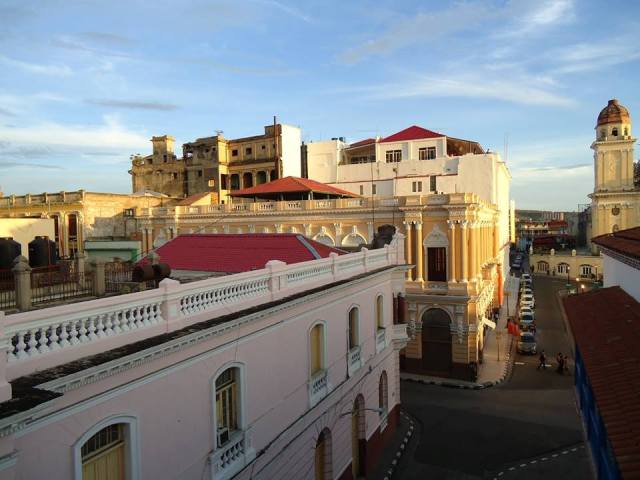The Panama Canal connects the North Atlantic Ocean with the North Pacific Ocean.

The legendary town of Santiago de Cuba, founded in 1515 by the Spaniard Diego Velázquez, celebrates its 506th anniversary this July 25th and it is distinguished by the natural charm that generates the idiosyncrasy of its people, the unequalled flavor of authentic rum, the aroma of coffee, its contagious music and its history.
According to research and historical documents, it was founded as a point of reference to the site where the Céspedes Park is today and in 1522 it reached the category and rank of City.
Through its buildings, its walls, its squares and narrow streets, Santiago de Cuba reveals every moment of its history. There you can enjoy the boleros,the son, the trova, the tobacco and the rum, and inhale the smell of the sea that rises to the city from the bay of Santiago.
Also in Santiago you can admire the contrast between the mountains and the sea, furrowed in other times the sea, once ploughed by corsairs and pirates like the fearsome Jacques de Sores.
Hence Spain's decision to build in that part of its Cuban colony, the San Pedro de la Roca del Morro fortress, declared a UNESCO World Heritage Site.
There are in Santiago de Cuba more than 15 museums that treasure facts like out of legends, because of their transcendence.
In the oldest part of the city there is a residential sector known as El Tibolí, where French-Haitian traditions survive, recalling the arrival of French settlers who fled the war in Haiti in 1791.
The typical congas of the city are those of Los Hoyos and Paso Franco, contagious for their rhythm. It is rare to find an inhabitant of this city, and even those who visit it, who remain motionless when they hear this music with pure santiaguero flavor.
And while we are on the subject of music, the cultural heritage of this locality is also enriched by the trova, the roots of which were the end of the 19th century during the days of the War of 95. It has a house in the center of town, which is an ideal place for the evocation.
Located in the heart of the city, next to the Céspedes Park, the Diego Velázquez House is preserved, considered the oldest in the Americas, with its turned balustersin the windows, floors of waxed planks and colonial furnishings.
Padre Pico Street is a unique attraction because it has the peculiarity of being made up of 52 steps, grouped in 13 blocks of four steps, and 12 bases of rest.
Céspedes Park is the main square of the city. Around it ther are very significant buildings such as the old City Hall, the house of Diego Velázquez, the Cathedral and the Casa Granda hotel.
The Cathedral of Santiago de Cuba holds the incredible record of being rebuilt and remodeled for different reasons. Of eclectic architecture, it has at the same time some classical architectural elements: Corinthian columns, arches, towers and marble sculptures.
While the Balcony of Velázquez is considered one of the most important viewpoints of the city, since it allows to appreciate buildings, mountains and the bay of Santiago, which was built between 1538 and 1550, in order to locate a battery that would serve as a defense.
A symbolic gateway to the Historic Center opens in the Plaza de Marte, which was the public space where Spanish soldiers exercised in the 18th century, hence its name, Campo de Marte, after the God of war in Greek mythology.
Famous streets? Well, the populous Enramadas, one of the main streets of Santiago, named as such in the XVIII century. It was the city's main artery where the religious processions went to the Cathedral. Its name is due to the fact that the settlers erected guano arbors that at the same time that mitigated the heat served as decorations.
In the Casa de la Trova, a very bohemian place, you can listen to good traditional Cuban music in a very attractive atmosphere due to the design of the place, walls upholstered with photos of artists from all over the world. It is visited by many tourists and among the most famous is Paul McCartney, member of the Beatles.
And if it is a matter of celebrations that define Santiago de Cuba, the Fiesta del Fuego (Fire Festival), which annually in July brings together visitors from several countries and each edition is dedicated to a Caribbean nation. Full of color, joy and surprises is presented at this cultural event.
But we must also talk about the carnivals, considered by many as one of the best events in the world, which in its origins in the seventeenth century and throughout the eighteenth century had a predominance of Spanish music, then the guitar was replaced by the African drum in the late XVIII century and first half of the XIX century until the present day.
Many places of interest, music, rum, tobacco, kindness spread to the seas by its people, that and much more distinguishes this tourist destination, discover it, for sure you will love it.

The Panama Canal connects the North Atlantic Ocean with the North Pacific Ocean.